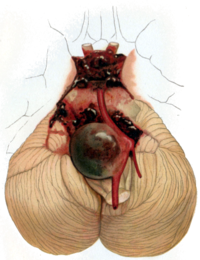
Photo from wikipedia
BACKGROUND Open cerebrovascular surgery remains an irreplaceable tool in the neurosurgeon's armamentarium for cerebral aneurysms. Among open approaches, the supraorbital keyhole approach provides a novel approach with less soft tissue… Click to show full abstract
BACKGROUND Open cerebrovascular surgery remains an irreplaceable tool in the neurosurgeon's armamentarium for cerebral aneurysms. Among open approaches, the supraorbital keyhole approach provides a novel approach with less soft tissue dissection and cortical exposure compared to the traditional pterional approach. OBJECTIVE To perform a descriptive synthesis of the published literature on cerebral aneurysms approached surgically via the supraorbital keyhole approach. METHODS Following PRISMA guidelines, we performed a systematic literature review of PubMed, Scopus, and Web of Science. Patient demographic data, aneurysm characteristics, Hunt and Hess score, clipping rate, operative time, post-operative neurologic status, length of stay, and follow-up were extracted. We then performed a meta-analysis to obtain pooled estimates of these metrics across studies, including assessments for cross-study heterogeneity and publication bias. RESULTS Under a random effects estimate, mean intraoperative rupture rate was 6.0%. Clipping rate was 99% under a pooled fixed estimate. Significant publication bias was found within studies for aneurysm clipping rate. Forest plot analysis revealed an average clinical outcome of 93% of a modified Rankin score from 0 to 2 or Glasgow Outcome Score of IV to V at post-operative follow-up. CONCLUSIONS Aneurysm treatment is highly heterogeneous within the current literature. The supraorbital keyhole approach is an effective strategy for aneurysm treatment.
Journal Title: World neurosurgery
Year Published: 2022
Link to full text (if available)
Share on Social Media: Sign Up to like & get
recommendations!